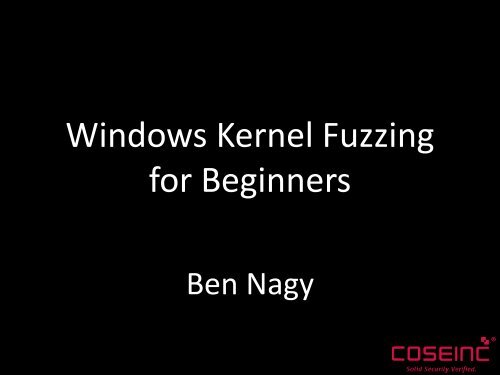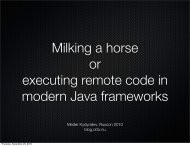Create successful ePaper yourself
Turn your PDF publications into a flip-book with our unique Google optimized e-Paper software.
Windows Kernel Fuzzing<br />
for Beginners<br />
Ben Nagy
ohai.<br />
- Not oldsk00l. Just old.<br />
- ~ 5 weeks experience with Windows Kernel<br />
- > 5 years experience with Fuzzing<br />
- Hate all Technology<br />
- Ruby and Drinking Make the Pain Go Away<br />
Disclaimer:<br />
I am aware of the prevailing opinion that fuzzing talks<br />
without bugs suck, by definition. I do not have any bugs. Even<br />
if I did have bugs, I wouldn’t tell you. There are no bugs.<br />
There are, however, otters and buff Russian men of dubious<br />
sexuality. Also, many red boxes. You have been warned.
Secret Fuzzing Wisdoms<br />
• Select a Good Target<br />
• Acquire Essential Knowledge<br />
• Apply Fuzzing Canon - DIGS<br />
– How do we Deliver<br />
– How do we Instrument<br />
– How do we Generate<br />
– How does that Scale
Secret Fuzzing Wisdoms<br />
• Delivery, Instrumentation, Generation<br />
– Gotta keep em separated!<br />
– Please stop writing heavily coupled tools, kthx<br />
• A good toolchain allows rapid retargeting<br />
– Start fuzzing with a stupid generator<br />
– Cold cores find no bugs!
Target Selection<br />
n_bugs = p_bug * n_tests<br />
• p_bug / testing speed is inherently target specific<br />
• Can tune the equation<br />
– Better ( possibly slower ) Generators<br />
– More Scale<br />
– Rapid Tooling ( lead time counts! )<br />
– Better Samples<br />
– Pre Fuzzing Toolchain
p_bug++<br />
• Feedback Driven Fuzzing<br />
– Via code coverage, success rate or some other metric<br />
– Eg SAGE, bunny, EFS, Flayer<br />
– PRO - Awesome, super elite, finds bugs dumb fuzzers will never hit<br />
– CON – Slow, difficult to write, poor Windows support<br />
• Fault Injection / deeply instrumented fuzzing<br />
– Inject bad data close to code being attacked<br />
– PRO - vastly simplifies delivery<br />
– CON - need to then check reachability<br />
• Corpus Distillation<br />
– Low effort, high reward technique<br />
– Need a way to measure coverage ( tricky for <strong>kernel</strong> stuff )
Target Selection<br />
n_bugs = p_bug * n_tests<br />
• More broadly, n_bugs isn’t interesting<br />
• Are there USEFUL bugs in there<br />
• If there are, can we locate them<br />
– Bug Chaff<br />
– Post Fuzzing Toolchain
Target Selection<br />
n_bugs = p_bug * n_tests<br />
• Bug Utility is SUBJECTIVE<br />
• Sell Use Fix Disclose<br />
• Whatever our utility metric, can we REALISE VALUE<br />
– Will it provide USEFUL CAPABILITY<br />
– Is it RELIABLY exploitable<br />
– Will anyone buy it anyway<br />
– Is it worth fixing<br />
– Will it bring us fame and imply great sexual prowess
Windows Kernel, Simplified<br />
• Featuring “Barry the Kernel Otter”<br />
• Some stuff is completely missing or wrong<br />
• All of it is greatly simplified<br />
• Real resources abound!<br />
– MSDN ( new layout / navigation is awesome )<br />
– Anything by j00ru, Alex Ionescu, Tarjei Mandt<br />
– Anything by Russinovich / Solomon / Probert<br />
– “CRK” is an academic course, freely downloadable<br />
– “WRK” is a full windows <strong>kernel</strong> source tree, plus build tools
Userland<br />
<strong>kernel</strong>32<br />
ntdll<br />
“NT Executive”<br />
Dragons<br />
Hardware
Userland<br />
<strong>kernel</strong>32<br />
ntdll<br />
1. Setup syscall args<br />
2. syscall number in eax<br />
3. int2e / sysenter / syscall<br />
( “context switch” )<br />
“NT Executive”<br />
4. Lookup syscall in SSDT<br />
5. Dispatch to correct driver<br />
Dragons<br />
Hardware
Userland<br />
<strong>kernel</strong>32<br />
ntdll<br />
“NT Executive”<br />
IO USER GDI<br />
Dragons<br />
Other Complicated Stuff<br />
Hardware
Userland<br />
<strong>kernel</strong>32<br />
ntdll<br />
“NT Executive”<br />
IO USER GDI<br />
Dragons<br />
Drivers<br />
Are<br />
Other Complicated Stuff<br />
Layered!<br />
Hardware
• Windows IO is deeply async<br />
• Uses IO Request Packets ( IRP )<br />
• “Filter” Drivers can intercept these<br />
© Sven Micklish
Userland<br />
user32<br />
“NT Executive”<br />
IO USER GDI<br />
Daddy Issues<br />
Repressed Memories<br />
Hardware
USER runs the GUI<br />
• Windows, Menus, Cursors, Icons…<br />
© Sven Micklish
Userland<br />
gdi32<br />
“NT Executive”<br />
IO USER GDI<br />
Unladen Swallows<br />
Meaning of Life<br />
Hardware
Graphics Driver Interface<br />
• Basically, it draws stuff<br />
• Moved into <strong>kernel</strong> space ~NT4<br />
• Bitmaps, Fonts, Metafiles…<br />
© Sven Micklish
Userland<br />
user32 / gdi32<br />
“NT Executive”<br />
IO<br />
USER<br />
GDI<br />
Broccoli<br />
Drivers<br />
Win32k.sys<br />
Are<br />
Evil Clowns<br />
Layered!<br />
Hardware
Userland<br />
<strong>kernel</strong>32<br />
( Direct Syscall )<br />
ntdll / user32 / gdi32 / …<br />
“NT Executive”<br />
IO USER GDI<br />
Boring / Complicated<br />
Drivers<br />
Drivers<br />
More Complicated Stuff<br />
Drivers<br />
Hardware
Userland<br />
<strong>kernel</strong>32<br />
ntdll / user32 / gdi32 / …<br />
Hook<br />
“NT Executive”<br />
Hook<br />
IO USER GDI<br />
Boring / Complicated<br />
Drivers<br />
Filter<br />
Drivers<br />
More Complicated Stuff<br />
Drivers<br />
Hardware
Bug Classes<br />
• LocalLocal<br />
– Privilege escalation<br />
– Sandbox escapes<br />
– Trending upwards in importance<br />
• RemoteRemote<br />
– Used to be the shiznit, now plagued by issues<br />
– Firewalls<br />
– Were great for indiscriminate attacks, less for targeted<br />
• RemoteLocal<br />
– Require a user to do something<br />
– Attack via email, document, URL etc<br />
– Now the Rolls Royce of bugs
Attack Vector Evaluation<br />
• Coming ‘up’ from the hardware side<br />
– Will yield RemoteRemotes<br />
– Just like ‘normal’ network fuzzing<br />
– SMB, RDP, tcpip.sys, wifi, USB…<br />
– Reliability issues Stealth<br />
– Hardware differences<br />
Verdict: You first, guv.
Attack Vector Evaluation<br />
• SSDT Hooks / Filter Drivers / etc<br />
– Good for attacking 3 rd party drivers<br />
– Fuzzing logic itself really should be in-<strong>kernel</strong> (inflexible)<br />
– Public implementations available<br />
– http://code.google.com/p/ioctlfuzzer<br />
• Finding AV bugs seems too cruel to be sport<br />
• Can’t write drivers in Ruby
Attack Vector Evaluation<br />
• GDI is cool, because RemoteLocals<br />
– Historically bug prone<br />
• General Syscalls might be fun<br />
– LocalLocals, but easy to prototype<br />
• USER is tricky, only yields LocalLocals<br />
– Keyboard Layouts burned by Stuxnet<br />
– Plus, Tarjei already looked at it<br />
( Moment of Silence in honour of Bug Genocide )
Let’s hit GDI!!<br />
© Sven Micklish
GDI - Delivery Vectors<br />
• Here’s what I have so far<br />
– Fonts - TTF, OTF, FON….<br />
– Cursors - BMP, CUR (animated)<br />
– Metafiles - EMF, WMF<br />
– Images - JPEG, PNG (!!)<br />
• Not even close to complete<br />
– Metafiles cover a lot, though
GDI - Fonts<br />
• Great slides from BHEU12<br />
http://media.blackhat.com/bh-eu-12/Lee/bh-eu-12-Lee-GDI_Font_Fuzzing-Slides.pdf<br />
( MANY THANKS to Lee & Chan for also sharing code )<br />
• Fonts are tricky beasts<br />
• You can also embed them ( google EOT )<br />
• Simple 9 step process…
GDI - Fonts<br />
1. Load the fuzzed font from a file<br />
debug_info "Removing any old copies of #{font_file} "<br />
GDI.RemoveFontResourceEx(font_file, 0, nil) # never know<br />
added=GDI.AddFontResourceEx(font_file, 0, nil)<br />
• I’m NOT using FR_PRIVATE<br />
• Works for almost any font type<br />
• Protip - fix checksums<br />
– ( google B1B0AFBA )
GDI - Window Basics<br />
2. Create a Window Callback<br />
def window_proc(hwnd, umsg, wparam, lparam)<br />
case umsg<br />
when GDI::WM_DESTROY<br />
GDI.PostQuitMessage(0)<br />
return 0<br />
else<br />
# This handles all messages we don't explicitly process<br />
return GDI.DefWindowProc(hwnd, umsg, wparam, lparam)<br />
end<br />
0<br />
end
GDI - Window Basics<br />
• Lots of people put their logic in here<br />
– Handle WM_PAINT, WM_RESIZE etc<br />
– Lots of samples online do it this way, too…<br />
• I never found the need, but YMMV
GDI - Window Basics<br />
3. Register Window Class<br />
window_class = GDI::WNDCLASSEX.new<br />
window_class[:lpfnWndProc] = method(:window_proc)<br />
window_class[:hInstance] = hinst<br />
window_class[:hbrBackground] = GDI::COLOR_WINDOW<br />
window_class[:hCursor] = 0<br />
@atom = GDI.RegisterClassEx( window_class )
GDI - Window Basics<br />
4. Create a Window Instance<br />
@hwnd ||= GDI.CreateWindowEx(<br />
GDI::WS_EX_LEFT,<br />
# extended style<br />
poi(@atom),<br />
# class name or atom<br />
@opts[:title],<br />
# window title<br />
GDI::WS_OVERLAPPEDWINDOW | GDI::WS_VISIBLE, # style<br />
GDI::CW_USEDEFAULT,<br />
# X pos<br />
GDI::CW_USEDEFAULT,<br />
# Y pos<br />
@opts[:width],<br />
# width<br />
@opts[:height],<br />
# height<br />
0, # parent<br />
0, # menu<br />
hinst,<br />
# instance<br />
nil<br />
# lparam<br />
)
GDI - Fonts<br />
5. Get Font Face Name ( undocumented )<br />
success=GDI.GetFontResourceInfo(<br />
w_fname,<br />
sz,<br />
buf,<br />
2 # asks to receive a LOGFONTW in buf<br />
)<br />
lf=LOGFONTW.new buf # cast the buffer to a LOGFONTW<br />
GDI.WideCharToMultiByte( … lf[:lfFaceName].to_ptr …)
6. “Create” the Font<br />
GDI - Fonts<br />
logical_font<br />
= GDI::LOGFONTW.new<br />
logical_font[:lfHeight] = font_size<br />
logical_font[:lfFaceName].to_ptr.put_string(0,font_face)<br />
logical_font[:lfItalic] = 0<br />
logical_font[:lfCharSet] = GDI::DEFAULT_CHARSET<br />
@current_font=GDI.CreateFontIndirect logical_font<br />
raise_win32_error if @current_font.zero<br />
7. Select it into the DC for our window<br />
@old_font=GDI.SelectObject(dc, @current_font)
What are Device Contexts<br />
• Bits of screen or printer<br />
• Include “graphics attributes”<br />
• (eg brushes, fonts, etc)<br />
© Sven Micklish
GDI - Fonts<br />
8. How big is a ‘line’ of text<br />
# build the string one glyph at a time until the<br />
# text extent is greater than our rect width<br />
sz = GDI::SIZE.new<br />
until sz[:cx] > width || str.empty<br />
out
GDI - Fonts<br />
9. Actually draw some f**king text<br />
GDI.send(<br />
text_out_method, # ExtTextOutW / A<br />
dc,<br />
# device context<br />
0, # X start<br />
@current_y,<br />
# Y start<br />
GDI::ETO_GLYPH_INDEX, # For ‘raw’ mode<br />
this_line,<br />
# RECT<br />
out,<br />
# str to draw<br />
out.size,<br />
# size<br />
nil<br />
# lpDx<br />
)<br />
@current_y+=sz[:cy]
ETO_GLYPH_INDEX<br />
“ The lpString array refers to an array returned<br />
from GetCharacterPlacement and should be<br />
parsed directly by GDI as no further languagespecific<br />
processing is required. ”<br />
– MSDN<br />
( This is why we use ExtTextOut and not DrawText )
That Sucked!<br />
( Still better than Gtk tho )<br />
© Sven Micklish
Image: pavel-petel.tumblr.com - NSFW<br />
DEMO
GDI - Cursors<br />
hCursor=GDI.LoadCursorFromFile cursor_file<br />
raise_win32_error if hCursor.zero<br />
@old_cursor=GDI.SetCursor hCursor<br />
debug_info "Set cursor #{cursor_file}”<br />
• WTF Why no DC<br />
– The cursor is a shared resource!<br />
– Not supposed to change it unless mouse is over you<br />
– Pff, whatever.
GDI - Cursors<br />
@old_clip = GDI::RECT.new<br />
@clip = GDI::RECT.new<br />
GDI.SetForegroundWindow @hwnd # _try_ to get focus<br />
GDI.GetClipCursor @old_clip<br />
GDI.GetWindowRect @hwnd, @clip<br />
GDI.ClipCursor @clip # Clipping changes it<br />
GDI.ClipCursor @old_clip # Put it back<br />
• Really crappy / fragile method!<br />
– Works, though
Image: pavel-petel.tumblr.com - NSFW<br />
DEMO
Metafiles!<br />
• Like a ‘script’ of GDI commands<br />
• ‘Scalable’ == ‘Fun’<br />
• SetAbortProc used to be lolz<br />
© Sven Micklish
GDI - Metafiles - WMF<br />
if wmf_data[0..3] == "\xD7\xCD\xC6\x9A"<br />
debug_info “Aldus Placeable Metafile!"<br />
pdata = pstr( wmf_data[22..-1] )<br />
• WMF has no scaling / position data<br />
• APM header is a standard ‘nonstandard’<br />
• Provides the missing info
Cannot the Scaling! What do<br />
1. Play in MSPAINT.EXE<br />
– Uses GDI+ internally, converts to BMP<br />
– Draws the BMP to the DC<br />
2. Use Coordinate Spaces & Transforms API<br />
– Parse the APM Header<br />
– Do lots of annoying maths with pels and twips<br />
– Actually, just saying ‘pels’ and ‘twips’ is annoying<br />
3. Convert to EMF, play that<br />
– May lose some evil, but very easy to do
GDI - Metafiles - WMF & EMF<br />
emf_handle = GDI.SetWinMetaFileBits(<br />
pdata.size,<br />
pdata,<br />
dc,<br />
nil<br />
) # convert to EMF if required…<br />
raise_win32_error if emf_handle.zero<br />
GDI.PlayEnhMetaFile dc, emf_handle, rect<br />
GDI.DeleteEnhMetaFile emf_handle
Image: pavel-petel.tumblr.com - NSFW<br />
DEMO
GDI - JPEG / PNG<br />
The StretchDIBits function copies the color data for a<br />
rectangle of pixels in a DIB, JPEG, or PNG image to the<br />
specified destination rectangle. If the destination rectangle is<br />
larger than the source rectangle, this function stretches the<br />
rows and columns of color data to fit the destination<br />
rectangle. If the destination rectangle is smaller than the<br />
source rectangle, this function compresses the rows and<br />
columns by using the specified raster operation.<br />
- MSDN
GDI - JPEG / PNG<br />
To ensure proper metafile spooling while<br />
printing, applications must call the<br />
CHECKJPEGFORMAT or CHECKPNGFORMAT<br />
escape to verify that the printer recognizes the<br />
JPEG or PNG image, respectively, before calling<br />
StretchDIBits.<br />
- MSDN
Fine. Let’s be a Printer.<br />
1. ( Optional ) Get default printer<br />
buf=pstr( "\x00" * 260 )<br />
buf_sz=FFI::MemoryPointer.new( :ulong )<br />
buf_sz.write_ulong buf.size<br />
if GDI.GetDefaultPrinter buf, buf_sz<br />
buf.read_string buf=pstr( "\x00" * 260 )<br />
…<br />
( Or just specify “Fax” etc )
Fine. Let’s be a Printer.<br />
2. ( Optional ) Check for JPEG Support<br />
escape_code=FFI::MemoryPointer.new :ulong<br />
escape_code.write_ulong GDI::CHECKJPEGFORMAT<br />
# Check if CHECKJPEGFORMAT exists<br />
res=GDI.ExtEscape(<br />
printer_dc,<br />
GDI::QUERYESCSUPPORT,<br />
escape_code.size,<br />
escape_code,<br />
0,<br />
nil<br />
)<br />
if res > 0<br />
status=FFI::MemoryPointer.new :ulong<br />
res=GDI.ExtEscape(<br />
printer_dc,<br />
GDI::CHECKJPEGFORMAT,<br />
p_jpeg_data.size,<br />
p_jpeg_data,<br />
status.size,<br />
status<br />
)<br />
Yes, I realise you can’t read<br />
this….<br />
Just use one of the built-in<br />
printers like XPS or OneNote,<br />
they support JPEG.
3. Fill Out Bitmap Info Struct<br />
bmi_header<br />
= GDI::BITMAPINFOHEADER.new<br />
bmi_header[:biSize] = GDI::BITMAPINFOHEADER.size<br />
bmi_header[:biWidth] = img_width<br />
# top down image - negative height value<br />
bmi_header[:biHeight] = -img_height<br />
bmi_header[:biPlanes] = 1<br />
bmi_header[:biBitCount] = 0<br />
bmi_header[:biCompression] = GDI::BI_JPEG<br />
bmi_header[:biSizeImage] = img_data.bytesize
4. Do the Thing<br />
printer_dc=GDI.CreateDC nil, lpszDevice, nil, nil<br />
retval=GDI.StretchDIBits(<br />
printer_dc,<br />
0, # dest X<br />
0, # dest Y<br />
stretch_width || rand(1000), # width<br />
stretch_height || rand(1000), # height<br />
)<br />
0, # src X<br />
0, # src Y<br />
img_width,<br />
img_height,<br />
pstr( img_data ),<br />
bmi_header,<br />
GDI::DIB_RGB_COLORS, GDI::SRCCOPY<br />
If this returns > 0 then it is “scan<br />
lines copied”, which should be the<br />
same as your JPEG height. Yay.
Image: pavel-petel.tumblr.com - NSFW<br />
NO DEMO
One More Thing…<br />
# first 4 args are passed in registers.<br />
register_args=args.shift( 4 ).zip %w( rcx rdx r8 r9 )<br />
register_args.map! {|arg,reg| "mov #{reg}, #{arg}" }<br />
# the rest are passed on the stack<br />
stack_args=args.reverse.map {|arg| "push #{arg}"}<br />
stub_x64=[<br />
"mov r10, rcx",<br />
# don't know why<br />
"mov eax, #{syscall}",<br />
# syscall in eax<br />
"syscall",<br />
# make the call<br />
"add rsp, #{stack_args.size * 8}", # clean up the stack<br />
"ret"<br />
]<br />
asm = (register_args + stack_args + stub_x64).join "\n"<br />
opcodes = Metasm::Shellcode.assemble(<br />
Metasm::X86_64.new, asm<br />
).encode_string<br />
p_opcodes = FFI::MemoryPointer.from_string opcodes
One More Thing…<br />
Syscall.VirtualProtect(<br />
p_opcodes,<br />
p_opcodes.size,<br />
PAGE_EXECUTE_READWRITE,<br />
FFI::MemoryPointer.new( DWORD ) # receives old protection value<br />
)<br />
hThread = Syscall.CreateThread(<br />
nil,<br />
0,<br />
p_opcodes,<br />
nil,<br />
CREATE_SUSPENDED,<br />
nil<br />
)<br />
self.raise_win32_error if hThread.zero<br />
Syscall.CloseHandle hThread
1 Line Syscall Fuzzer!<br />
Syscall.call64<br />
rand(0x2000),<br />
*(Array.new(6).map {rand<br />
2**32}) until @bsod<br />
Basic technique stolen from jduck’s MS10-073 exploit,<br />
updated to work on x86 / x64. Props to the Metasm team.
Out of time!!<br />
• Did not talk about…<br />
• Case Generation<br />
– I mainly use ‘Millerfuzz’ & Radamsa from OUSPUG<br />
– ( and secret stuff )<br />
• Scale<br />
– Scaling by VM pairs has proved fragile<br />
– I use ‘checkpoints’ with auto-reboot on BSOD<br />
– You can test with NotMyFault tool<br />
– Any uncleared dump + checkpoint sent for analysis<br />
– VMs don’t always reboot cleanly <br />
– Private WER server may be better
kthxbai<br />
• As I mentioned, 5 weeks ago I<br />
knew ~nothing about the <strong>kernel</strong><br />
• Anything I got right is<br />
probably thanks to:<br />
– Lee & Chan for their code from BHEU12<br />
– Tarjei Mandt, Alex Ionescu, jduck<br />
– New MSDN Nagivation Interface<br />
– Luck
( ben at coseinc dot com )<br />









